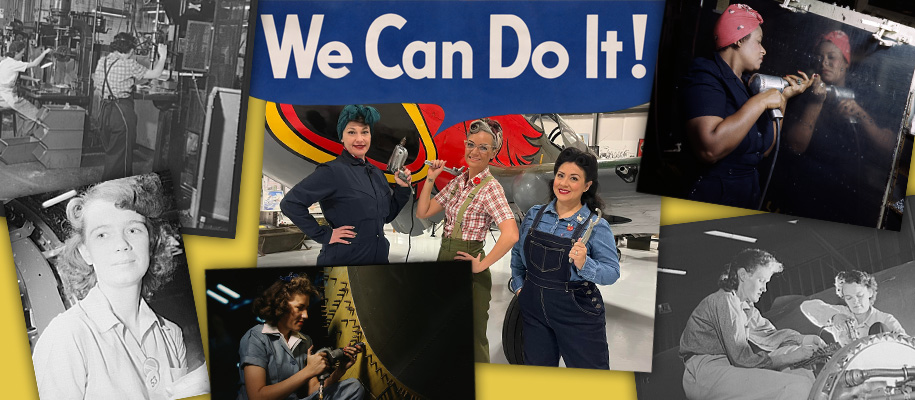
Posted On: March 15, 2023
Rosie the muse
As ubiquitous as the “We Can Do It!” poster is within the modern imaginings of the World War II zeitgeist, it actually had very little to no cultural impact at its display in early 1943. Hired by Westinghouse Electric in 1942, J. Howard Miller created a series of 42 posters to raise morale and reduce the chances of worker strikes in their factories. There was often tension between labor unions and management after the U.S. joined WWII as demand for goods increased and the number of male workers decreased, and propaganda posters were a popular public relations tool.1
This female Westinghouse worker, unnamed, was displayed for about two weeks in factories in East Pittsburgh, Pennsylvania and was most likely only meant as encouragement for the female workers making plasticized helmet liners.1
Rosie the Riveter’s actual first public appearance was a popular, self-titled, song released in February 1943 by Redd Evans and John Jacob Loeb. Not much is known about Loeb, but Evans was a composer, author, publisher, musician and record executive2. The song3 starts:
While other girls attend their fav’rite cocktail bar,
Sipping dry Martinis, munching caviar,
There’s a girl who’s really putting them to shame,
Rosie is her name…
All the day long, whether rain or shine,
She’s a part of the assembly line.
She’s making history,
Working for victory,
Rosie the Riveter.
Keeps a sharp lookout for sabotage,
Sitting up there on the fuselage.
That little frail can do,
More than a male can do,
Rosie the riveter.
The song continues to describe Rosie (“never twittery, nervous or jittery”; “smeared full of oil and grease”) and her responsibilities (protecting her boyfriend Charlie–a marine–by working overtime riveting, and “putting all her cash” into buying war bonds).
This introduction was quickly followed by Norman Rockwell’s contribution—a painting of Rosie on her lunch break, seated in front of the American flag that appeared on the cover of the Saturday Evening Post on May 29, 1943.4 This rendition of Rosie is a stark contrast to Miller’s, with her muscular arms, men’s shoes and oversized uniform. Though, importantly, she is still depicted with traditionally feminine touches (see “The patriotism of beauty, grooming & fashion during WWII”): styled red hair, red nail polish, red lipstick and a handkerchief and compact sticking out of her pocket. She sits with a foot on top of Hitler’s manifesto, Mein Kampf. The image became hugely popular and the Post loaned it to the U.S. Treasury Department for use on posters for their war bond drives.
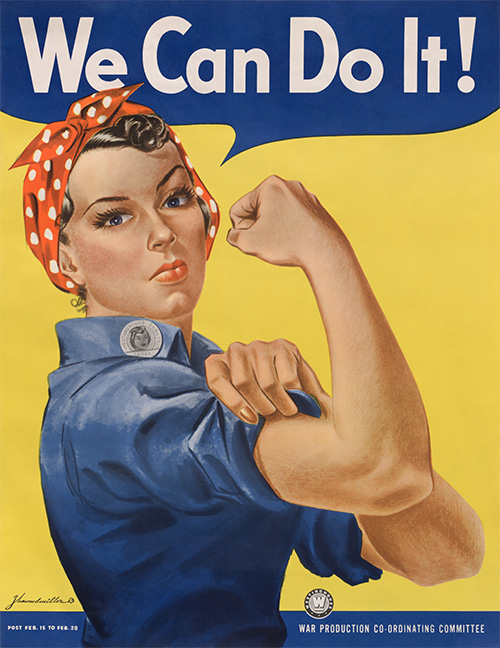
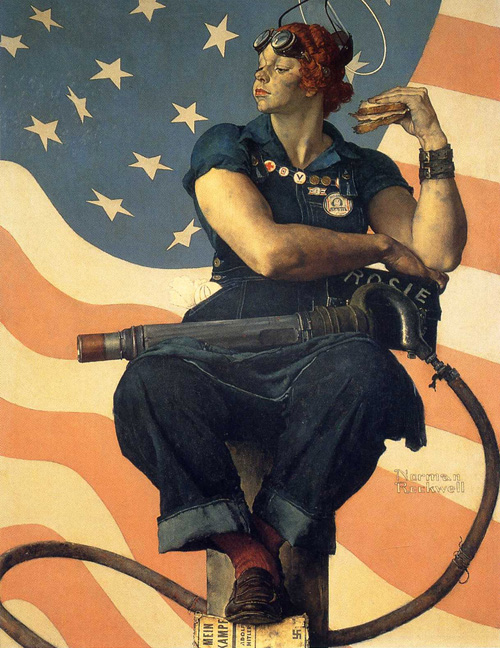
After the war, Rockwell’s Rosie was used less and less due to its copyrighted status and gradually faded from the public’s memory (though the original only gained in worth, selling for $5 million in 20021). In 1982, ironically due to its uncopyrighted state, Miller’s poster became popular for the first time. It was published in a magazine article in the Washington Post Magazine (“Poster Art for Patriotism’s Sake”) and, probably due to its seamless combination of femininity and strength, was appropriated as a feminist symbol. Since then, it has appeared on Smithsonian magazine’s cover, a U.S. Postal Service stamp, in a display at the National Museum of American History and has generally become the most recognizable image of Rosie.1
More than Riveting
Rosies took on many forms and many jobs during WWII. From 1940 to 1945, women in the workplace increased from 27% to 37%, with 19 million making up the labor force on the home front and 350,000 serving in the military.5 As impressive as the numbers were, women’s positions in the workforce changed even more drastically. Previously homemakers, domestic servants, secretaries, receptionists or store clerks, women answered their country’s call and took on work as streetcar operators, taxi drivers, and positions in construction, steel, lumber, munitions, agriculture, government and more.6 The number of women in the aircraft industry climbed to 65%. The numbers also received a boost after President Franklin Roosevelt signed an executive order in 1941 banning racial discrimination in the defense industry. This led to one million African Americans joining the workforce for the first time, 600,000 of which were women.7
After the release of the song and Rockwell’s poster, Rosie the Riveter became a symbol for women across the United States and a rallying call for women to take up previously male positions in order to free up a man to fight. Many of these women began referring to themselves as “Rosies”. Originally only meant to inspire patriotism, Rosie also came to be a symbol of female empowerment and liberation. Though paid significantly less than men in the same roles, many women enjoyed the new skills, confidence, and financial freedom that working provided. Though most were asked to leave their jobs or were demoted once the war ended, a great change in societal norms had begun.
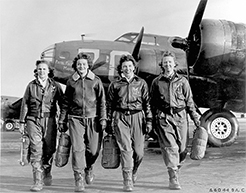
Sourced from: U.S. Air Force

Sourced from: Library of Congress
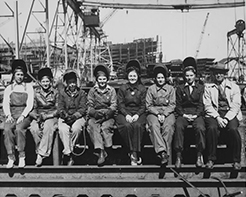
Sourced from: National Archives Catalog – NAID: 522890
The Warhawk’s Rosies
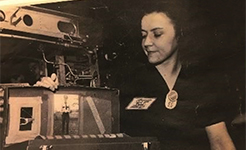
The Warhawk Air Museum Exhibit #13 has more Rosie information and artifacts, including from Bell Aircraft Corporation employee Grace A Pankow. Grace joined the workforce at age 18 attaching brake lines to airplanes on the assembly-line.
Read Grace’s story: Profiles in Courage: Grace A. Pankow
March 19 – Rosie the Riveter Day
Help Rosie take over the Warhawk Air Museum March 19, 2023 for Rosie the Riveter Day. Don your most riveting Rosie attire and get into the museum FREE! We will be featuring our home front and women in uniform displays.
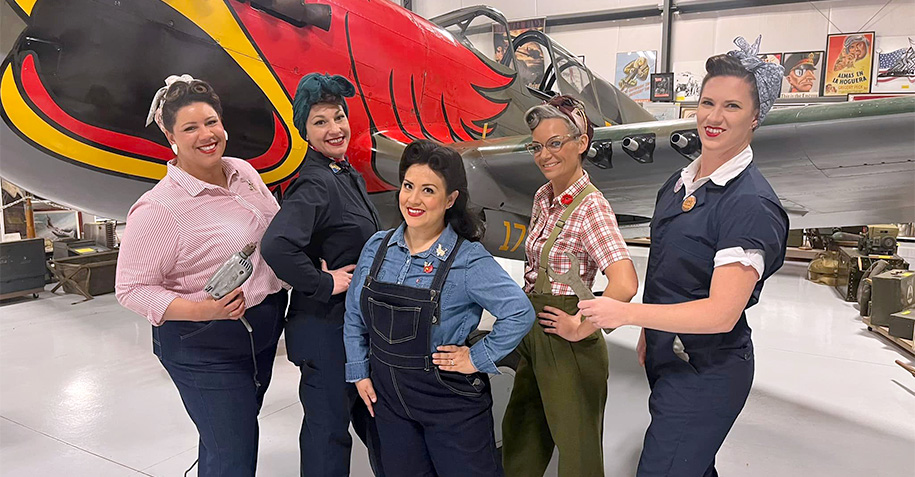
Resources:
- https://en.wikipedia.org/wiki/We_Can_Do_It!
- https://www.imdb.com/name/nm0263147/bio
- http://www.protestsonglyrics.net/Historic_Songs/Rosie-the-Riveter.phtml
- https://www.nrm.org/rosie-the-riveter/
- https://en.wikipedia.org/wiki/American_women_in_World_War_II
- https://www.history.com/news/how-world-war-ii-empowered-women
- https://www.history.com/news/black-rosie-the-riveters-wwii-homefront-great-migration




Love it! 5 stars!